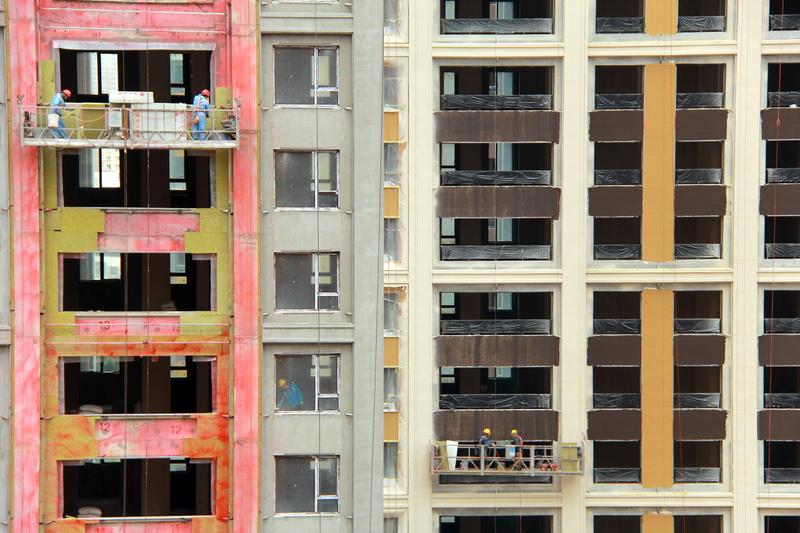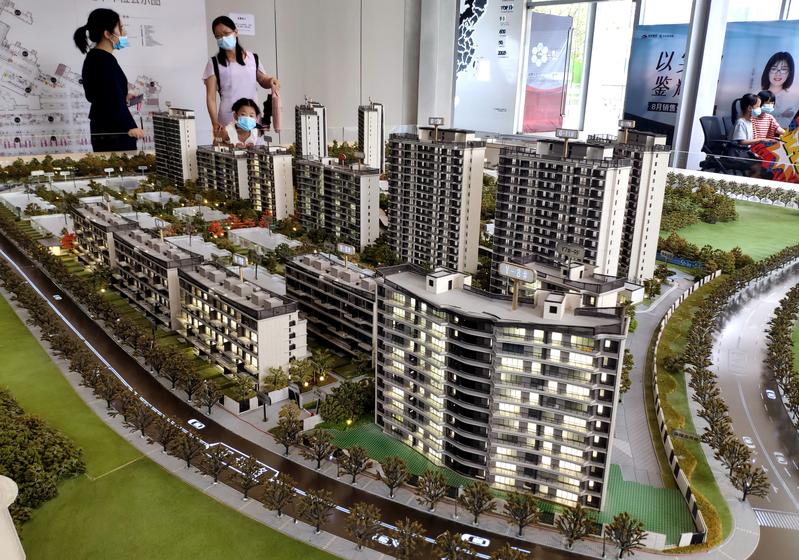Homebuyers may look forward to wider variety, green tinge, stable prices in 2022
 Potential homebuyers look at a model of a housing project in Huizhou, Guangdong province, on Dec 4. The national housing market remains stable, in line with the two principles of "houses are for living in, not for speculation" and "stability of the housing market should be maintained". (ZHOU NAN / FOR CHINA DAILY)
Potential homebuyers look at a model of a housing project in Huizhou, Guangdong province, on Dec 4. The national housing market remains stable, in line with the two principles of "houses are for living in, not for speculation" and "stability of the housing market should be maintained". (ZHOU NAN / FOR CHINA DAILY)
In recent months, newlywed Fan Chen and her husband have spent most of their spare time viewing various apartments across Shanghai as they are eager to settle down in the city this year.
"There may be market ups and downs, but that makes no difference to people like us, who are buying homes to live in," Fan said. The 28-year-old and her husband have been trying to zero in on a two-bedroom flat that is no farther than a half-hour subway commute to her office.
It is expected that as speculative investors step outside the market, real homebuyers will find more options for their dream homes.
Ding Zuyu, CEO of E-House (China) Enterprise Holdings Ltd
With speculators in China's residential property market facing regulatory action, prospective homebuyers such as Fan have become critical to demand for homes this year.
Other key factors are recent measures to stabilize land prices, home prices and market expectations, support to enhance variety in supply, and the establishment of a long-term development mechanism for the real estate market, said Ding Zuyu, CEO of E-House (China) Enterprise Holdings Ltd.
"It is expected that as speculative investors step outside the market, real homebuyers will find more options for their dream homes," Ding said.
Personal mortgage application procedures became shorter and easier recently in Shanghai, Chengdu, Sichuan province and Nanjing, Jiangsu province. Interest rates for home loans are also starting to edge down in Guangzhou and Shenzhen, Guangdong province, as well as Suzhou, Jiangsu province.
Looking back, there were some major changes taking place in the real estate industry, including the "two centralized" new policies introduced for land transfer in 2021, the regulation complementary to the "Three Red Lines" pilot policy introduced in 2020, and the autonomy to regulate the housing market that has devolved to the level of each city, said Shaun Brodie, senior director and head of occupier research of China at Cushman &Wakefield.
 Workers shape a housing project in Shenyang, Liaoning province, on Oct 5. Property investment stood at around 13.73 trillion yuan in the first 11 months of last year, up 13.2 percent from the same period of 2019, the pre-pandemic time. (WANG RUIZHONG / FOR CHINA DAILY)
Workers shape a housing project in Shenyang, Liaoning province, on Oct 5. Property investment stood at around 13.73 trillion yuan in the first 11 months of last year, up 13.2 percent from the same period of 2019, the pre-pandemic time. (WANG RUIZHONG / FOR CHINA DAILY)
Nevertheless, the national housing market remains stable, in line with the two principles of "houses are for living in, not for speculation" and "stability of the housing market should be maintained", Brodie said.
"The property sector was further returning to its initial characteristics of people's livelihood in 2021, thanks to consistent efforts to reduce home speculation and pay equal attention to home-buying and leasing," said Xie Chen, head of research at CBRE China.
Owing to effective financial measures, listed property developers saw their net debt ratio decline 4 percentage points year-on-year in the first half of 2021, Xie said.
In November, the majority of 70 large and medium-sized Chinese cities saw meager growth in their new and existing home prices compared with the prices a year ago, and their month-on-month growth rate fell too, according to the National Bureau of Statistics.
Property investment stood at around 13.73 trillion yuan ($2.16 trillion) in the first 11 months of last year. Compared with the same period of 2019, property investment climbed 13.2 percent, putting the two-year average at 6.4 percent, the NBS said.
Analysis of past few years' NBS data found that although many Chinese cities experienced month-on-month home price dips, 13 cities still reported an increase in new home prices and four cities saw a rise in pre-owned home prices, said Ding with E-House (China).
These cities include hot spot first- and second-tier cities such as Beijing, Shanghai, Hangzhou, Zhejiang province, and Xiamen, Fujian province, as well as a few lower-tier cities such as Yinchuan, Ningxia Hui autonomous region, Pingdingshan, Henan province, and Sanya, Hainan province, Ding said.
Industry experts said the changes took place in 2021, which may better ensure market stability and sustainability in the coming years. Considering the stance of the central government to promote healthy development of the property market, both challenges and opportunities will mark this year. And housing market expectations will be further stabilized too.
The annual Central Economic Work Conference held in Beijing from Dec 8 to 10 sent clear signals that a new round of stable growth is well underway, and that the real estate sector is going to achieve a soft landing by meeting rational home living requirements, said a report by Ren Zeping, chief economist at Soochow Securities.
Reaffirming that "houses are for living in, not for speculation", the conference listed ensuring healthy growth of the real estate sector as one of the nation's key tasks for 2022. It stressed that the nation will accelerate the development of the long-term rental housing market, push forward the construction of government-subsidized housing projects, support the real estate market to better meet reasonable demand of homebuyers and effect differentiated policy measures in accordance with each city's specific conditions, so as to promote the property sector's healthy development and form a virtuous cycle.
 Local residents inquire about newly built homes in Fuzhou, Fujian province, on Sept 12. Policymakers listed ensuring healthy growth of the real estate sector as one of China's key tasks for 2022. (LYU MING / CHINA NEWS SERVICE)
Local residents inquire about newly built homes in Fuzhou, Fujian province, on Sept 12. Policymakers listed ensuring healthy growth of the real estate sector as one of China's key tasks for 2022. (LYU MING / CHINA NEWS SERVICE)
The property sector is large, has a long supply chain and a wide outreach, and accounts for a high proportion of the economy, fixed asset investment, local governments' income and financial institutions' loans. It has a vital systemic impact on economic and financial stability and risk prevention, said Han Wenxiu, an official with the Central Committee for Financial and Economic Affairs, at a conference held in Beijing on Dec 11.
Experts said the meeting of the Political Bureau of the Communist Party of China Central Committee on Dec 6 and the Central Economic Work Conference shed more light on opportunities.
For example, China will support the property market to better cater to reasonable demand of homebuyers and adopt city-specific policies to boost the virtuous cycle and healthy development of the sector.
"Such expressions as a continuation of previous guidance for the sector showed the central government's resolve to replace the previous model of high leverage, high debt and high turnover with a more sustainable and higher-quality solution," Xie said.
The overall financing environment for homebuilders will be further regulated to reduce corporate debt and mitigate financial risks. At the same time, relevant policies will ensure that the household leverage ratio is kept at a sustainable level. Real estate enterprises will actively expand financing channels, optimize the debt structure and improve debt security, experts said.
A certain amount of demand in the housing market tends to remain irrespective of circumstances. Combined with demand from first-time homebuyers, the two aspects should help raise the quality of residential housing to greener, healthier and better levels. As a result, China's residential housing market will begin to pay increasing attention to user needs in the long run.
The government will also help maintain steady development of the market. With appropriate policy support, the market is expected to develop in a more sustainable manner, analysts said.
"The government has made clear that it will accelerate the development of the long-term rental housing market, which will encourage real estate enterprises to invest more in asset-light projects like long-term rental apartments," said Brodie with Cushman& Wakefield.
In addition, as some urban clusters integrate regional resources, strong second- and third-tier cities in the Yangtze River Delta region, the Guangdong-Hong Kong-Macao Greater Bay Area and the Beijing-Tianjin-Hebei region may see more residential projects, which means further business opportunities will likely emerge for builders in these regions, he said.
Furthermore, Chinese people's health awareness will create opportunities for projects featuring green buildings, healthy buildings, smart buildings and professional facility management, said Xie with CBRE China.
The nation's goal to achieve carbon neutrality by 2060 and rising environmental, social and governance requirements for listed enterprises will promote companies in the real estate sector to strike a balance among economic efficiency, environmental protection and social benefits, Xie said.


